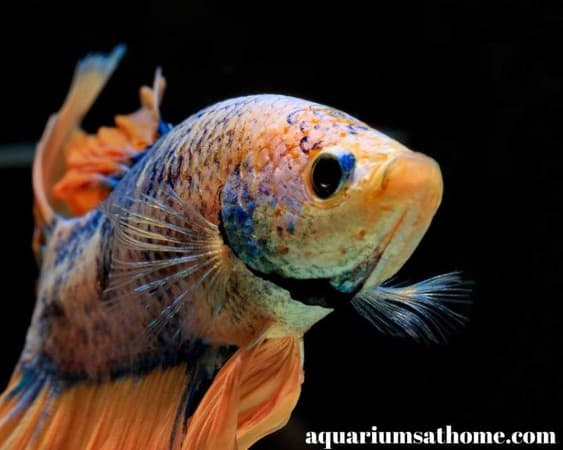There is nothing worse than watching a pet get sick and feel helpless to do anything to help. Fin rot is one of those preventable diseases (a preventable disease) that shouldn’t ever be an issue however it does happen. The biggest problem with a preventable fish disease like Fin Rot is that yes, it can overcome and can kill your betta fish.
Below I will do my best in explaining what causes fin rot and what you can do to remedy the issue and fingers crossed save your beloved pet betta from succumbing to this easily preventable disease.
Fin Rot Symptoms
If you notice any discoloring on the edge of the betta’s fins you most likely have Fin Rot developing. The discoloring is usually a milky color.
The problem with identifying Fin Rot is it is hard to recognize unless you check your fish daily. Once the rot sets in the fins will start to fray which then leads to parts of the fins and possibly tail dying and falling off.
Eventually the Fin Rot will make its way to the fish’s body and that’s when it’s game over for the fish.
What causes fin rot in betta and other fish?
Fin rot can be caused by different strains of bacteria mainly the Pseudomonas, Vibrio, Fluorescents and the Aeromonas bacteria. These bacteria’s are usually triggered by your tanks environmental conditions, the tank the fish was purchased from and just over all stress of the fish.
It doesn’t take much to stress out a small creature like a fish. Just think of the fish living in the fish stores aquarium with other random fish or if it was stuck in one of this tiny 16 ounce fish bowls they call betta tanks. Living in those conditions can cause stress.
Then the fish is put in a plastic bag and brought home. Now the fish has been bouncing around in the bag making its way back to your home. Then you place the fish in a quarantine tank or its final living tank and could be stressed from the environment in another new home.
Now that the betta is in its new home there could be other nippy fish chasing it around causing stress or if the aquarium is overcrowded and even worse if the food is old and stale dated.
If the tank water itself is not at the correct levels or the proper temperature these can also lead to your fish getting fin rot.
So from the above information you can see that it is very important to ensure you transport your fish safely and if you need more info on transporting aquarium fish check out my article on that topic here.
It is also extremely important to have your aquarium water set to the proper parameters for Nitirite, Nitrate and Ammonia. For a well explained article on the Nitrogen cycle which is the term used for cycyling your tank to get to these appropriate levels check out that article here.
What does fin rot look like?
As mentioned at the beginning of this article fin rot looks like the outer edges of the fins are turning color and getting somewhat ragged. The more the disease progresses the more ragged the fins get with pieces of the fins starting to fall off. It will look like another fish has been nipping on the diseased fish’s fins. You will know that’s not what happened though because of the discoloring taking place.
Do betta fish fins grow back after fin rot – do torn betta fins grow back
Yes betta’s can grow their fins back as long as there wasn’t so much damage that the fish will have a hard time surviving anyways.
It will take some time before you see new growth but eventually you should notice a somewhat clear piece growing in place of the missing areas. Over time these new pieces of fin will start to take the color on of the rest of the fish however might be a shade or two off from the original coloring.
A torn fin might not heal up properly depending on just how long the tear is. It also might not matter to the mobility of the betta anyways, just depends where the tear is.
Just make sure when you have a fish recovering from losing parts of its fins that you provide it with a safe and calm environment so the fish is not stressed or picked on by other fish. If your betta gets stressed during this time it might not grow the pieces of fin back as desired.

Best Ways to Prevent Fin Rot
- Only feed your fish the best food you can afford. And do not over feed. Overfeeding will cause more bacteria to grow. If you do overfeed you can syphon the excess up. Alternatively you could keep a school of Cory Catfish or something similar to help ensure the bottom of the tank stays fairly clean.
- Do your best not to overcrowd the aquarium. I know firsthand how tempting it is to load up the tank with as many fish as you can afford. Unfortunately this causes problems on the bio-load of the tank which means ammonia levels will spike and you do not want that. As well overloading can cause stress for your fish. Stress is one of the causes of Fin Rot.
- Regular water changes are a must for every aquarium. Regular water changes take the contaminants out of the aquarium giving the tank a boost of life so to speak. Some newbies to the hobby worry doing a water change will put their water parameters out of whack where on the contrary doing this helps to keep the levels of Nitrite, Nitrate and Ammonia in check.
- Putting a bit of “aquarium salt” in your tank after every 2nd water change or so. Some hobbyists recommend putting some in after every water change and that might work however I would be concerned with the salinity level rising to high in the tank and eventually harming some of the fish. Aquarium salt does not evaporate, it is accumulative and only leaves the tank when you take water out. So if you keep adding when you’re not doing water changes you will have a problem. One way to ensure your salinity is not getting carried away is to check it after each water change with a salinity meter. This will take you literally 30 seconds and it will safe your fish.
How Do You Treat Fin Rot and the Best Fin Rot Treatment
- If you have a quarantine or hospital tank I would recommend moving your betta to that tank especially if you have other living creatures in your tank. The other inhabitants do not need to be exposed to the procedures below. Plus you want to separate them from the infected fish ASAP.
- Make sure to take out carbon inserts in your filter when adding medication to a tank otherwise the medication will not be effective as the carbon will remove the medication from the water.
- Make sure the water temperature is turned up to at least 78 Fahrenheit.
- Turning the aquarium lights off during the medication phase will help to reduce stress to the fish.
- If you are okay with using a medication right away then I highly recommend using Melafix as the best Fin Rot treatment. You can check it out on Amazon here.
- If you do decide to use medication a good tip for you is to make sure you have extra air added to the water. The reason is that medication will absorb oxygen out of the water and your fish could suffocate.
- If you don’t want to use medication you can put “aquarium salt” in the water for treatment. Putting 1 teaspoon per gallon of water until the Fin Rot is healed completely. I wouldn’t use this process any longer than 7 to 10 days. If the fins are not looking better in this amount of time I am afraid you wil have to consider using an antifungal medication. As I just mentioned above I like Melafix for this job.
- As mentioned above water changes are important to do during the maintenance of your tank as well to keep doing the water changes during treatment of your betta. When you do a water change you can add more salt for every gallon of water you have replaced.
Is Fin Rot Contagious
Fin rot is very contagious. The bacteria that has infected your fish will spread throughout the tank if not treated immediately after noticing there is an issue.
The best you can do to ensure other fish are not infected is to take the sick fish out of the tank and place into a quarantine tank to be treated. I have heard others that say take the healthy fish out and place them into your quarantine tank and then treat the sick tank and fish together. That method also works. It is a lot more work but works.
How To Tell if Fin Rot is Getting Better [Can Fin Rot be Reversed]
This question is answered above in do betta fins grow back after fin rot.
One thing I did not mention in that section is that the fish will seem to have more energy again and will be swimming around like a healthy fish. That’s when you know the fish will be healing.
The treatments in this article will help you heal Fin Rot in most fish and not just a betta. The key to never run into this problem in the first place is to follow the tips I have laid out in this article. Always ensure your aquarium is as healthy of an environment as possible for all of the inhabitants. Otherwise why be in the hobby?
Related Posts
How to Cure Popeye in Betta Fish
Do Betta Fish Prefer Long or Tall Tanks?






